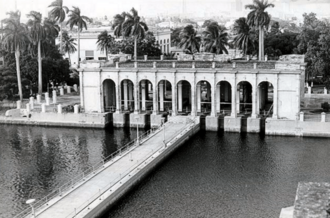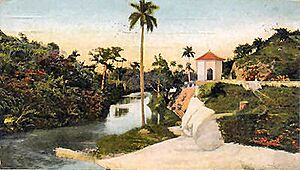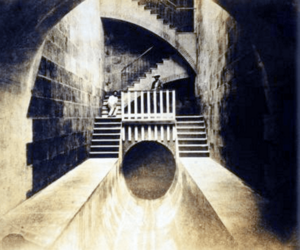Albear Aqueduct facts for kids
Quick facts for kids Albear Aqueduct |
|
|---|---|
|
Acueducto de Albear
|
|

Palatine Deposit
|
|
| General information | |
| Town or city | Havana |
| Country | Cuba |
| Coordinates | Lua error in Module:Coordinates at line 614: attempt to index field 'wikibase' (a nil value). |
| Construction started | 1861 |
| Completed | 1893 |
| Design and construction | |
| Engineer | Francisco de Albear |
The Acueducto de Albear (Albear Aqueduct) is a famous water system in Havana, Cuba. It was built in the 19th century by a talented engineer named Francisco de Albear. This amazing system still provides water to parts of Havana today!
Contents
Why it was Built
In the early 1800s, Havana had a big problem: not enough clean water. This led to serious health issues, like outbreaks of diseases such as cholera. People were getting sick from dirty water.
To fix this, in 1852, the Governor of Cuba, José Gutiérrez de la Concha, asked a special group to find a solution. This group was led by Francisco de Albear, who was a colonel in the Spanish army's engineering team. Their main goal was to build a new water system to make the city healthier.
Finding the Best Water Source
De Albear and his team did a lot of research to find the best water source. They looked at several rivers and springs. They finally chose the del Vento springs because the water was very clean. Also, these springs were 41 meters (about 135 feet) higher than the city. This meant the water could flow to Havana using just gravity, without needing pumps!
It took a few years of careful studies to make sure the springs could provide enough water for the whole city. Finally, in 1855, De Albear presented his detailed plan.
The Spanish government in Madrid approved the plan in 1858. To pay for the huge project, they decided to use money from other water systems and add a small fee for water use.
What the Aqueduct System Includes
Even though it's called an aqueduct, the Albear project is a very complex water supply system. It includes many different parts:
- Dams to create storage areas for the spring water.
- Special structures in the Vento area to manage the water.
- Filters to clean the water.
- A tunnel to carry water across the Almendares River.
- A long canal to bring water all the way to the city.
- Water treatment facilities.
- Large water storage tanks and water towers.
- A network of pipes to deliver water to homes throughout the city.
How the Canal Works
The main canal of the aqueduct has an oval shape. It is about 2.40 meters (almost 8 feet) deep and 1.98 meters (about 6.5 feet) wide. It has a slight slope that allows water to flow by gravity.
At normal water levels, the canal can carry about 1.67 cubic meters of water per second. This is enough to supply 144,000 cubic meters of water every day! If needed, it can even carry more water, up to 302,800 cubic meters daily. When it was designed, the goal was to provide about 500 liters (132 gallons) of water per person each day.
Building the System
Construction began in 1861 under Francisco de Albear's leadership. However, the work was very slow. This was because there wasn't enough money, and there were problems due to the Ten Years' War in Cuba.
Building the water pipes inside the city didn't start until 1874. De Albear first created a detailed map of Havana. Then, he designed the entire pipe network and decided where the water storage tanks would go.
The first part of the canal was finally finished in 1878. This allowed water to start flowing into the city, which was a huge relief for the people of Havana.
Finishing the Project
Sadly, Francisco de Albear became sick with malaria and passed away on October 22, 1887. He didn't get to see his amazing project fully completed.
His assistant, Joaquín Ruiz, took over and continued the work. The last part of the project was finished by an American company. The entire Albear Aqueduct system was officially opened on January 22, 1893, 45 years after it first began!
Later Upgrades
Over the years, the aqueduct needed to be expanded as Havana grew.
- From 1925 to 1931, new parts were added, including a new water basin and a pumping station. Gardens and decorative elements were also added around the water facilities.
- Between 1947 and 1948, a large new pipe was installed. This helped bring even more water to different parts of the city, like Vedado and Luyanó.
Awards and Recognition
The Albear Aqueduct was recognized as a masterpiece of engineering.
- It won a prize at the Centennial Exposition in Philadelphia in 1876.
- It also received a Gold Medal at the World's Fair in Paris in 1878.
Many people consider it one of the seven wonders of Cuban engineering, alongside other impressive structures like the Bacunayagua Bridge and the FOCSA Building.
Still Working Today
The Albear Aqueduct is still active and working! It's incredible because it doesn't use electric power. It relies only on the natural force of the springs to push the water.
Today, it supplies water to five central areas of Havana: Havana Vieja, Centro Habana, Cerro, October 10, and Plaza de la Revolution. This means it provides water for about 12% of Havana's population!
Because of its importance and historical value, the Albear Aqueduct was declared a National Monument of the Republic of Cuba on January 9, 2009. This honor also included other historic water systems in Havana, like the Zanja Real and the Fernando VII Aqueduct.
See also
 In Spanish: Acueducto de Albear para niños
In Spanish: Acueducto de Albear para niños
- Francisco de Albear




